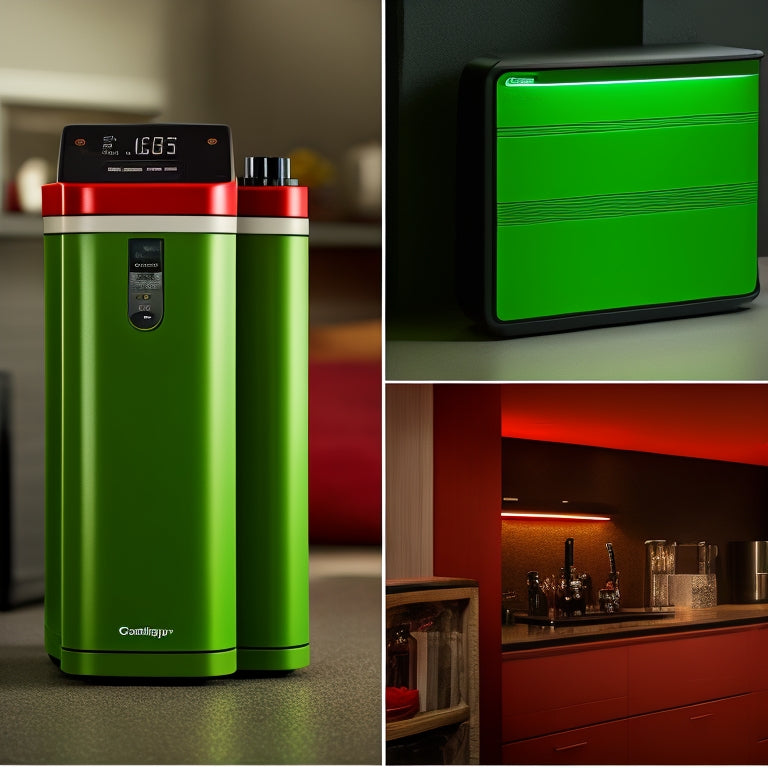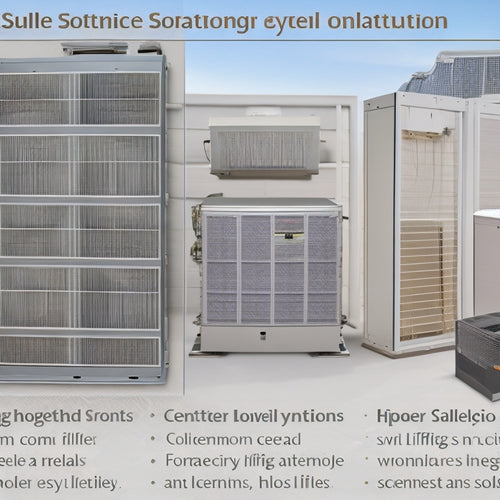
Why Do Home Batteries Last Longer Than Expected?
Share
You've invested in a home battery system expecting a certain lifespan, but surprisingly, it's outperforming its predicted durability, and that's due to several key factors. Rigorous manufacturer testing, high-quality battery cell materials, and advanced management systems all play a role in optimizing energy flow and minimizing wear and tear. Efficient charging cycles, smart charging algorithms, and real-time monitoring also contribute to longer-than-expected battery life. As you investigate the complexities of home battery systems, you'll reveal even more factors that influence performance and realize how to maximize your investment's potential.
Key Takeaways
- Rigorous manufacturer testing and validation ensure home batteries meet performance and safety standards, leading to longer lifetimes.
- High-quality battery cell materials, such as lithium iron phosphate, contribute to longevity and performance, reducing wear and tear.
- Advanced battery management systems, including predictive maintenance and real-time monitoring, optimize energy flow and minimize battery degradation.
- Efficient charging and discharging practices, such as avoiding deep cycling, prevent memory effects and reduce maintenance costs.
- Regular software updates and maintenance, combined with warranty coverage and support, enable home batteries to operate at peak performance and extend their lifespan.
Manufacturer Testing and Validation
During the development phase, manufacturers put their home batteries through rigorous testing and validation processes to confirm they meet the required safety and performance standards. You expect your home battery to provide reliable power when you need it most, and manufacturers ascertain this by simulating real-world scenarios.
They conduct a battery lifecycle assessment to evaluate the battery's performance over its entire lifespan. This involves performance benchmarking against industry standards, testing for durability, and verifying the battery's ability to handle varying temperatures, depths of discharge, and charging cycles.
Additionally, they consider factors such as energy storage needs and energy density to guarantee peak performance. By doing so, manufacturers can confidently claim their home batteries will last longer than expected, giving you the freedom to live life off the grid without worrying about power outages.
High-Quality Battery Cell Materials
As you consider the longevity of your home battery, it's essential to understand the critical role high-quality battery cell materials play in ensuring its reliability and performance.
The type of lithium chemistry used greatly impacts the battery's overall lifespan. High-quality electrode materials, such as lithium iron phosphate or nickel manganese cobalt oxide, are necessary for maintaining ideal performance and longevity.
The responsible sourcing of battery minerals, such as lithium sustainable EV production, is also important in ensuring the long-term reliability of home batteries.
Advanced Battery Management Systems
You're likely aware that a home battery's lifespan greatly depends on its charging patterns and energy flow.
That's where advanced battery management systems come in, utilizing efficient charging cycles to minimize wear and tear on the battery.
By leveraging Predictive Maintenance Tools facilitating proactive issue detection, these systems can identify potential issues before they arise, guaranteeing peak performance and extending the battery's lifespan.
These systems also employ real-time monitoring and optimized energy flow to make certain your battery operates within a safe and efficient parameter.
Efficient Charging Cycles
One key factor influencing home battery longevity is the implementation of efficient charging cycles, which relies heavily on advanced battery management systems.
These systems optimize charging efficiency by controlling the flow of energy to and from the battery. By doing so, they prevent overcharging, which can reduce cycle longevity.
Additionally, integrating energy storage systems, like those used in solar-powered EV charging stations energy self-sufficiency, can further enhance efficient energy consumption.
You'll benefit from advanced algorithms that adjust charging rates based on factors like temperature, state of charge, and battery health. This precision control guarantees your battery operates within a safe and efficient window, extending its lifespan.
With efficient charging cycles, you can enjoy a longer-lasting home battery that supports your energy independence.
Real-time Monitoring Systems
Advanced battery management systems, also known as real-time monitoring systems, play a critical role in extending home battery longevity. These systems provide you with real-time analytics, enabling you to track your battery's performance and identify areas for improvement. By monitoring your battery's state of charge, voltage, and temperature, you can adjust your energy usage habits to enhance its lifespan.
| Parameter | Real-time Monitoring | Benefits |
|---|---|---|
| State of Charge | Tracks battery capacity | Prevents overcharging/undercharging |
| Voltage | Monitors voltage fluctuations | Reduces risk of battery damage |
| Temperature | Regulates operating temperature | Guarantees peak performance |
With real-time monitoring, you can make informed decisions about your energy usage, reducing the risk of battery degradation and guaranteeing your home battery lasts longer than expected.
Optimized Energy Flow
The sophisticated design of advanced battery management systems enables enhanced energy flow, an essential factor in prolonging home battery longevity.
You benefit from this enhanced energy flow as it improves energy efficiency, allowing your home battery to store and supply power more effectively.
By leveraging solar power, renewable energy solutions, advanced systems integrate seamlessly with renewable energy sources, such as solar panels, to maximize energy harvesting and minimize waste.
This intelligent energy management guarantees your home battery operates within ideal parameters, reducing wear and tear, and extending its lifespan.
Optimal Charging and Discharging
You'll want to enhance your home battery's charging and discharging habits to maximize its lifespan.
Deep cycling, which involves regularly draining the battery to its recommended minimum capacity, can actually benefit your battery's health.
Deep Cycling Benefits
By optimizing charging and discharging patterns, homeowners can access the full potential of their home batteries, and deep cycling is an essential aspect of this process.
You'll want to guarantee your battery is regularly cycled between 20% and 80% capacity to maximize its cycle longevity. This deep cycling approach helps to prevent memory effects, which can reduce your battery's overall performance.
By doing so, you'll optimize your battery's performance, allowing it to store and release energy more efficiently. This translates to a longer lifespan and reduced maintenance costs.
Smart Charging Algorithms
Advanced home battery systems rely on smart charging algorithms to optimize charging and discharging patterns, guaranteeing your energy storage unit operates at peak efficiency.
These algorithms use adaptive learning to analyze your energy usage patterns and adjust charging cycles accordingly. This smart energy management system reduces wear and tear on your battery, extending its lifespan.
Some key features of smart charging algorithms include:
- Real-time monitoring of energy demand and supply
- Automated charging and discharging schedules
- Peak shaving to reduce strain on the grid
- Load shifting to optimize energy storage
- Energy forecasting to guarantee efficient charging
Regular Software Updates and Maintenance
Your home battery's performance and longevity heavily rely on regular software updates and maintenance. This guarantees that your battery's management system is optimized to adapt to your user behavior and usage patterns. By receiving regular updates, your battery can fine-tune its charging and discharging cycles, leading to improved overall efficiency.
| Update Type | Frequency | Benefits |
|---|---|---|
| Security patches | Monthly | Protects against cyber threats |
| Performance optimization | Quarterly | Improves charging efficiency |
| Feature enhancements | Bi-annually | Adds new functionality |
| Diagnostic tools | Annually | Enhances maintenance capabilities |
| Firmware upgrades | As needed | secures compatibility with new hardware |
Environmental Factors and Control
Optimizing your home battery's performance and longevity involves more than just software updates and maintenance.
You also need to take into account environmental factors and control them to guarantee your battery lasts longer.
-
Temperature fluctuations can greatly impact your battery's performance, so it's vital to install it in a location with stable temperatures.
-
Humidity levels also play an important role, and you should make certain your battery is protected from excessive moisture.
-
Installation quality is paramount, as a poorly installed battery can lead to reduced performance and lifespan.
-
Ambient conditions, such as seasonal variations, can affect your battery's performance, so it's crucial to take these factors into account when choosing a location.
-
Ventilation efficiency and location impact also need to be factored in to make sure your battery operates within ideal conditions, which are influenced by your usage habits.
Real-World Usage Patterns Analysis
In conjunction with environmental factors, analyzing your real-world usage patterns is essential to maximizing your home battery's performance and longevity. By understanding how you use your battery, you can optimize its performance and extend its lifespan. Your usage trends, such as daily energy consumption and charging habits, directly impact your battery's performance metrics.
| Usage Trends | Performance Metrics |
|---|---|
| Daily energy consumption | Depth of discharge (DOD) |
| Charging frequency | Cycle life |
| Peak power demand | Round-trip efficiency |
| Time-of-use energy shifting | State of charge (SOC) |
Battery Depth of Discharge Rates
Battery depth of discharge (DOD) rates play a critical role in determining the overall health and lifespan of your home battery.
When you understand how to manage your battery's DOD, you can maximize its discharge efficiency and extend its lifespan. Here are some key factors to take into account:
-
A lower DOD means your battery will last longer, as it reduces wear and tear on the cells.
-
Most home batteries are designed to operate within a 20-80% DOD range to maintain ideal health.
-
Avoiding deep discharges (below 20%) helps prevent cell damage and prolongs battery lifespan.
-
Shallow discharges (above 50%) reduce the number of charge cycles, which also contributes to a longer lifespan.
-
By monitoring and controlling your DOD rates, you can enhance your battery's performance and enjoy a longer, more reliable energy storage solution.
Warranty Coverage and Support
As you've enhanced your home battery's depth of discharge rates to maximize its lifespan, it's equally important to contemplate the warranty coverage and support that comes with your energy storage solution.
You should carefully review the warranty terms to understand what's covered and for how long. A thorough warranty can provide peace of mind, protecting your investment and guaranteeing you're not left with unexpected repair or replacement costs.
Look for manufacturers that offer extended warranty options and dedicated customer support. This support should include online resources, phone support, and on-site assistance when needed.
Having a reliable support system in place can greatly reduce downtime and guarantee your home battery continues to perform effectively throughout its lifespan.
Frequently Asked Questions
Can Home Batteries Be Used as Backup Generators During Outages?
You can use home batteries as backup generators during outages, providing reliable backup power and energy independence; they seamlessly switch to backup mode, ensuring your home remains powered and connected, giving you freedom from grid reliance.
Do Home Batteries Require a Lot of Maintenance and Upkeep?
You'll be surprised to know that 80% of battery failures are due to inadequate maintenance. To maximize your home battery's lifespan, you'll need to contemplate key factors like depth of discharge, temperature, and charging cycles, which impact maintenance frequency, ensuring your battery stays healthy and efficient.
How Do Home Batteries Handle Power Surges and Electrical Storms?
You'll be relieved to know that your home battery is equipped with advanced power surge protection and electrical storm resilience, safeguarding your system from voltage spikes and ensuring uninterrupted energy supply during intense weather conditions.
Can I Install Home Batteries Myself, or Do I Need a Pro?
As you commence on a quest for energy independence, you're tempted to conquer the installation of home batteries alone, but beware: steering through complex installation guidelines and DIY considerations without a pro can lead to a treacherous path of safety risks and efficiency losses.
Will Home Batteries Work With My Existing Solar Panel System?
You'll be relieved to know that most home batteries are designed for seamless solar integration, ensuring battery compatibility with your existing system, so you can store excess energy and enjoy greater freedom from the grid.
Related Posts
-

Why Solar HVAC Filters Revolutionize Home Energy Efficiency
By adopting solar HVAC filters, you're shifting your home's energy reliance from fossil fuels to clean, renewable sou...
-

Why Transform Human Waste Into Garden Gold?
By changing human waste into garden gold, you'll reduce waste management costs, support sustainable agriculture, and ...
-

Why EVs Inspire Earth-Conscious Home Design Choices
As you shift to an electric vehicle, you're not just switching to a greener ride, you're igniting a broader commitmen...


